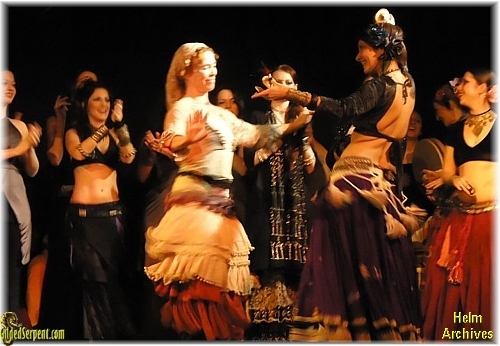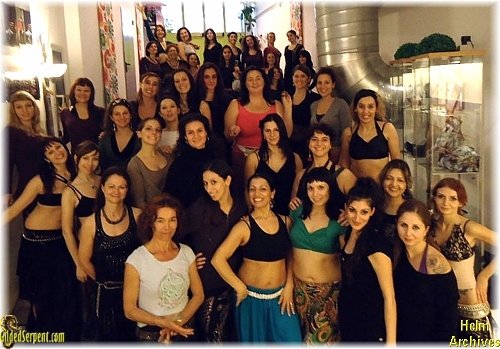Roma Tribal Forum
More of Helm’s Musical Adventures

by Ling Shien Bell
posted September 8, 2011

Twelve years ago, Isabel De Lorenzo moved from Brazil to Rome, where she met Lara Rochetti. In the center of Rome, next to the ancient fortified wall called “Le Mura”, they opened “San Lo”. This studio and dance school for all ethnic dance styles, presenting also theater and contemporary arts, was a new vision for a country rapidly changing with so many emigrants. Isabel created the first American Tribal Style (ATS) troupe in the area, Carovana Tribale, and invited Geneva Bybee to teach Tribal Fusion. The growing interest for both styles of Tribal Dance inspired them to hold a Tribal Meeting in this ancient city.
Isabel met Mark Bell and I when we were playing at the Sleeping Lady in Fairfax, California, and invited us to teach at the Roma Tribal meeting she was planning to hold at San Lo.

Ling Shien teaching Fellahi and Sa’idi

Mark and the Takadum Orchestra
An interesting highlight of this meeting was the Tribal Forum, held on the last day, where dancers gathered in a circle and shared their views on the major dance trends under the umbrella name “Tribal Belly Dance” and what that term meant.

Tribal Forum
As we went around the circle, Isabel asked me to recount my involvement with Helm and the traditional Middle Eastern music we’ve been playing for dancers since the ‘80s.
After meeting Mark Bell, I started playing in the Southern Renaissance Faire in Malibu, California, where we were joined by the great oudist, Henri Besançon, to accompany the Soux Ashe’s Montrebi Troupe. In 1987, when we moved north, we performed at the Northern Renaissance Faire in Blackpoint, for Sage Hoban: Gypsy Moor Dancers, which eventually evolved into John Compton’s Hahbi Ru, performing choreographed dances from Jamila Salimpour’s Bal Anat, and the Pita Guli Balkan Dance Troupe. Both these troupes had been performing at the Northern Faire in the ‘70s, with some dancers (Mish Mish and Kathy Bulk) leaving Bal Anat to join Pita Guli… Mark was the main drummer for the Bal Anat Troupe in those days.
The style performed by these troupes was still not labeled as “Tribal” at that time, but more as “Ethnic”, as opposed to “Cabaret”. It featured traditional folkloric acoustic music, and costumes with coins, camel belts and Assiut cloth (from Assiut, Egypt) rather than sequins and high-heeled shoes. It also differed from the Cabaret style in the fact that most of the dances were group dances.
Now there seems to be two main currents within the Tribal Dance trend: American Tribal Style, originated by Carolena Nereccio, and Tribal Fusion, encompassing a wide variety of genres. Tribal Fusion usually includes some of the original ATS moves and either original moves or moves borrowed from other dance forms. One major difference between the two, though, seems to be that ATS, with its specific dance vocabulary and overall look in the costume, is based on group improvisation. Tribal Fusion performances are mostly choreographed, and offer a wide variety of costume styles.
At the Tribal Forum, dancers took turns around the circle, describing their own take on Tribal dance.
Francesca, who founded De Nova Luce, wanted to have more emotion in the dance, and called her style Emozionale. In her troupe’s performance the night before, the chorus portrayed a “Bas Relief” or partially embedded sculpture, and Francesca was emoting in the foreground.

Mandagora Troupe of Barcelona at the Saturday show.
Kimberly Mackoy remembered the beginnings of Tribal Fusion with Rachel Brice, who, after studying with Carolena, quickly shaped a new style that she called “Tribal Fusion”.
Kimberly, who has an ethnology background, saw the word tribal from an anthropological point of view: a family or group of related people with a mode of life or lifestyle (dedication to the tribe as opposed to the individual). A tribe, in this sense, perpetuates traditions over generations.
Then I chimed in with the musician’s perspective. Mark and I have spent the last 30 years researching and teaching musical traditions that have evolved over generations of a tribal life style, whether nomadic or stationary, and as we play them, one can feel a sense of happiness, wisdom, and power that these musical melodies and rhythms convey. The differences and similarities of these forms gives us a sense of the time and space through which they originated and merged.
This research is a continuing fascinating adventure as we travel, learn, teach, and receive positive feed back from the natives, who are happy that someone is interested in their folklore.
(Coming soon: Our article on our research trip in Rajastan)
The Roma Tribal show’s finale (see video below) featured all the artists dancing to Helm and the Takadum Orchestra. Isabel invited me to dance with her. How could I resist? The rhythm was happening!

Isabel and Ling Shien

Helm joined the Takadum Orchestra at the festival’s performance

The closing tea party was a chance to say farewell to our new friends until Tribal Roma 2011!
Names? Ling in front in light tshirt, almost directly behind is Ilhaam, more?

Have a comment? Use or comment section at the bottom of this page or Send us a letter!
Check the "Letters to the Editor" for other possible viewpoints!
Ready for more?
- 7-9-09 Ling Shien demonstrates the Accordion
She came to the Gilded Serpent studio to tell us how she has modified a standard western made accordion to be able to play the quarter tones required in many of the Arabic modes. - 10-16-08 Solstice Festival in Catalunia, Spain
For the third year in a row, Maria Cresswell produced a dance and music festival honoring the Summer Soltice. This year’s three day event took place high up in the Catalunian Pyrenees, in a rustic hostel fed by fresh springs and bordered by a rushing river. - 5-17-06 Making New Musical Inroads in Luxembourg 2005
Helm takes Rhythm Diatribes Workshops to Europe. It was extremely educational for us to watch the learning process in three very diverse regions. - 4-11-06 Adventure Amid the Tempest: The Biloxi Fest’s Near Brush with Hurricane Katrina,
Consequently, we did not allow Hurricane Katrina stop us from driving 450 miles to immerse ourselves in and perform with Mark and Ling Shien Bell of Helm! MORE PHOTOS ADDED! - 9-6-05 Making New Musical Inroads in Spain
Helm takes Rhythm Diatribes Workshops to Europe, series continues… - 5-10-05 Making New Musical Inroads in France and Ireland
Helm takes Rhythm Diatribes Workshops to Europe, series continues… - 4-19-05 Helm takes Rhythm Diatribes Workshops to Europe
The musicians will be conducting a series of rhythm/music workshops in Ireland, Spain and Luxembourg this April. - 6-10-03 North Beach and Mark Bell
A lot of my getting the jobs was because I was there available when the opportunity arose. - 7-16-11 Carnival of Stars, Page 1: A-C Photos
The Carnival of Stars Festival is produced by Pepper Alexandria and Latifa at the Richmond Auditorium each year at the beginning of August. The stage at this facility is hard to beat. The wonderful lighting and the large stage make every dancer feel like a diva! Once again, Carl has done an amazing job catching the character of each dancer. - 7-13-11 On the Road to Zimbabwe! Queen of Denial, Part 5 by Rebaba
I think it was around this time when I had gotten to know my co-workers and escorts well enough to allow them to try explaining their way of life and thinking processes to me, that I realized I was in a “no win” situation. - 7-12-11 Ask Yasmina #16, New Baby Dance, Taqsim Shimmies, and Cane Music
However, there are many who had to resort to Cesarean after a long and arduous labor as well. It might be negligent to throw around such claims. - 7-9-11 Egyptian Percussion Instruments by Dr George Dimitri Sawa
From the medieval era to our own time, Arabic music has been predominantly rhythmic. For this reason, much effort has been spent to write a theory of Arabic rhythms. - 7-7-11 Permits, IDs, Licensing, Foreign Dancers in Cairo,
It dawned on me that some dodgy nightclub manager, whom I didn’t know personally, had complete control over my passport and my freedom to leave! So, I had no alternative other than to end my contract in order to get my passport back which also meant halting the lengthy paper process. - 7-6-11 Dancing with Tigers, In China with Fleurs d’Egypte
We had no idea what to expect of the actual location. However, with ticket and costumes in hand, we rode the wave. Arriving late at night, we were ushered to our rooms and straight to bed to sleep off our jet lag. We had no concept of the overwhelming size of the park and over-the-top eye-candy awaiting us the next morning! - 7-5-11 Becoming the Object of Your Own Fantasy, "Perfumes of Araby" in the 1970s, Part 1
The Belly dance scene in 1970s Los Angeles: It is difficult to spotlight succinctly even one portion of a vibrant, vast and quickly growing community of Middle Eastern dancers, their enthusiasts, and the ethnic communities, musicians, festivals and supper clubs that supported the dance arts. The abundance of inspiration in that era was almost beyond understanding; yet once upon a time before the Internet, music, imagery and information was less readily available. - 7-4-11 Inaugural "Art of the Belly" Festival Rings in Spring in Style, Bellydance comes to Ocean City, Maryland
Inside the hotel, waves of positive energy radiated all around. People were not just glad to be at this festival, they were honored. If you were from Maryland, this was your belly dance festival. Dancers were representing both themselves and the elements of various fusions. They wanted this to be done right. - 6-29-11 Photos from Rakkasah West 2011, Pg 4: Sunday M-Z by Carl Sermon
Maria, Nadika, Naiya-Hayal, Onyx Moon, Oreet, Raks Al Khalil, Raks Terayz, Raks the Casbah, Reda Darwish, Ruby, Sabiba, Sassafras, Shimmy Amour, Tatseena’s Troupe, Terry, Titanya, Troupe Aneena, Yolanda, Zahara - 6-26-11 Dancer Cancer, Part One: "Hopping on One Foot
Still, I was confident that there would be no further problem and that I was letting my vanity get the best of me. By wanting to look good, I had caused all my own discomfort, I reassured myself. He said I would have the biopsy report in a few days and to call my referral doctor to hear what the UC San Francisco laboratory report said. - 6-24-11 Dancing on the Roof of the World, Community Festival in Tajikistan .
After all my many travels to Tajikistan, filled with the frantic bustle of dance lessons, rehearsals, teaching, doing trip logistics, hunting for traditional bits and bobs for costuming, and getting fitted for stage costumes, I finally decided to try being a more-or-less normal tourist in one of my favorite places on Earth, the Pamir mountains of Badakhshan, eastern Tajikistan. - 5-31-11 Serpent Tour 2011 Journal- London, Madrid and Marrakech! NEW VIDEO UPDATE-7-8-11
An experimental travel blog. Let see how it goes! The plan is to update this page frequently.
Rohit
Dec 2, 2012 - 07:12:02
Hello,
I am amazed at the similarity between an indian tribal dance form music ,instruments and this roma tribal dance.
great job..